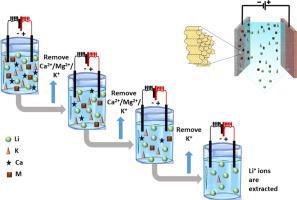当前位置:
X-MOL 学术
›
Electrochim. Acta
›
论文详情
Our official English website, www.x-mol.net, welcomes your feedback! (Note: you will need to create a separate account there.)
Recovery of lithium by pseudocapacitive electrodes in capacitive deionization
Electrochimica Acta ( IF 6.6 ) Pub Date : 2024-04-13 , DOI: 10.1016/j.electacta.2024.144267 Muhammad Faheem , Rahat Alam , Ahmed Alhajaj , Linda Zou
Electrochimica Acta ( IF 6.6 ) Pub Date : 2024-04-13 , DOI: 10.1016/j.electacta.2024.144267 Muhammad Faheem , Rahat Alam , Ahmed Alhajaj , Linda Zou

|
Lithium is a crucial component in rechargeable lithium-ion batteries for many applications, including the powering of electric vehicles and stationary energy storage systems. This investigation focused on two hybrid pseudocapacitive materials, the polystyrene sulfonate-MXene composite (PM) and the sodium titanate/graphene oxide composite (NG), for lithium ions recovery from aqueous Li resources. This was achieved by selectively removing unwanted divalent Ca and Mg ions, as well as monovalent ions, through capacitive deionization (CDI) using a single-cell system, resulting in a final solution enriched with Li ions. Based on the ion selectivity order observed previously as Mg≈ Ca > > Li, a series of CDI experiments were conducted with sequential steps to remove more selective ions first and to obtain a lithium-enriched solution with higher purity and maximum extracted fraction. Both PM and NG electrodes demonstrated promising performance when tested in binary, ternary, and quaternary ionic solutions with the recovered lithium solution purity in the range of 59.09 %-95.94 % and 59.75 %-77.17 %, respectively. Further, the highest enrichment factor values observed were ; 268.1 for PM and ; 44.25, for NG electrodes. The PSS-modified MXene composite electrode in obtaining the Li solution with the highest purity when separated Ca from a binary solution. These findings offer valuable insights into the selective electrosorption of divalent ions over lithium ions through the utilization of ion intercalation pseudocapacitive nanocomposite electrodes. The obtained results hold significance in advancing novel non-precipitation techniques for the recovery of lithium ions from aqueous lithium resources.
中文翻译:

电容去离子中赝电容电极回收锂
锂是可充电锂离子电池的重要组成部分,适用于许多应用,包括电动汽车和固定储能系统的供电。本研究重点关注两种混合赝电容材料,即聚苯乙烯磺酸盐-MXene复合材料(PM)和钛酸钠/氧化石墨烯复合材料(NG),用于从水性锂资源中回收锂离子。这是通过使用单池系统进行电容去离子 (CDI) 选择性去除不需要的二价 Ca 和 Mg 离子以及一价离子来实现的,从而形成富含 Li 离子的最终溶液。基于之前观察到的离子选择性顺序为 Mg≈Ca>>Li,我们进行了一系列 CDI 实验,分步骤首先去除更多选择性离子,并获得具有更高纯度和最大萃取分数的富锂溶液。在二元、三元和四元离子溶液中进行测试时,PM 和 NG 电极均表现出良好的性能,回收的锂溶液纯度分别在 59.09 %-95.94 % 和 59.75 %-77.17 % 范围内。此外,观察到的最高富集因子值为; 268.1 为 PM 和; 44.25,对于 NG 电极。 PSS修饰的MXene复合电极在从二元溶液中分离Ca时获得最高纯度的Li溶液。这些发现为通过利用离子嵌入赝电容纳米复合电极选择性电吸附二价离子相对于锂离子提供了有价值的见解。所获得的结果对于推进从水性锂资源中回收锂离子的新型非沉淀技术具有重要意义。
更新日期:2024-04-13
中文翻译:

电容去离子中赝电容电极回收锂
锂是可充电锂离子电池的重要组成部分,适用于许多应用,包括电动汽车和固定储能系统的供电。本研究重点关注两种混合赝电容材料,即聚苯乙烯磺酸盐-MXene复合材料(PM)和钛酸钠/氧化石墨烯复合材料(NG),用于从水性锂资源中回收锂离子。这是通过使用单池系统进行电容去离子 (CDI) 选择性去除不需要的二价 Ca 和 Mg 离子以及一价离子来实现的,从而形成富含 Li 离子的最终溶液。基于之前观察到的离子选择性顺序为 Mg≈Ca>>Li,我们进行了一系列 CDI 实验,分步骤首先去除更多选择性离子,并获得具有更高纯度和最大萃取分数的富锂溶液。在二元、三元和四元离子溶液中进行测试时,PM 和 NG 电极均表现出良好的性能,回收的锂溶液纯度分别在 59.09 %-95.94 % 和 59.75 %-77.17 % 范围内。此外,观察到的最高富集因子值为; 268.1 为 PM 和; 44.25,对于 NG 电极。 PSS修饰的MXene复合电极在从二元溶液中分离Ca时获得最高纯度的Li溶液。这些发现为通过利用离子嵌入赝电容纳米复合电极选择性电吸附二价离子相对于锂离子提供了有价值的见解。所获得的结果对于推进从水性锂资源中回收锂离子的新型非沉淀技术具有重要意义。



























 京公网安备 11010802027423号
京公网安备 11010802027423号